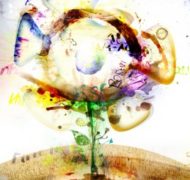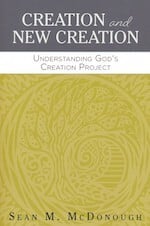Penguin Perched on HCB Iceberg Weaves Art from HTML Code: Interview with Artist Harold Sikkema
Blog / Produced by The High Calling
Harold Sikkema is a recent honors graduate of McMaster University in Ontario, Canada. He met L.L. Barkat at IAM’s Encounter 10 and was invited to join us here as an artist. He’s a fascinating person and we thought you should meet him.
MD: What do you do for High Calling Blogs?
HS: At this point, I’m a penguin, perched on the HCB iceberg . . . and L.L. has invited me to dive in and go under and around it for an exploratory swim. She has been commenting on my images, so I have a feeling that the visual output of my home studio will be my primary contribution.
MD: You’re a visual artist, but you also design websites, carry expertise in graphic design, and have experience with computer lab maintenance and troubleshooting. How does your artwork reflect or draw from these skills?
HS: I grew up speaking Dutch at home and English at school, so I’ve always seen reality in multilingual terms. Art and technology also have their respective vocabularies, each designed to highlight various aspects of the worlds they describe. In web programming, there are languages for data storage and retrieval, logic, document markup, visual layout, and user interaction. Generally, a painting also has a kind of logic and markup, but it’s expressed in the more tactile terms of texture and color.
My technical background helps me to appreciate the complexities of underlying structures; as a result, I tend to be more ambitious in articulating nuanced visual structures in my art. I see how it’s possible to integrate the poetry of code with the poetry of paint but I also find that, while coding, my strategic work is informed by my holistic “big-picture thinking” —what you might associate with painterly composition-building.
MD: I’ve heard that your art is “quite unique”. How would you describe it?
HS: A few months ago, I began calling my pieces “digital tapestries”. For me, the word “tapestry” recovers a kind of trustworthiness that is lacking in many digital art forms. The manipulation of images is not about twisting or distorting reality but about weaving it together cohesively, as one does with thread on a loom. Also, the process of hand-weaving is labor-intensive. I want the tactile roots of my images to be obvious . . . to capture that I might well have spent six hours manually arranging literal stones just to achieve the first of many digital layers in an image. In addition, the wide format of tapestry is used often as a “vessel” for narrative — for storytelling — and I’m always looking for new ways to tell the story of redemption.
MD: Last year you exhibited in an amazing half-dozen art shows at various venues in Hamilton, Ontario, all one after the other. How did you manage to be in so many back-to-back exhibitions?
HS: The reality is that I didn’t manage it . . . at least not well. I already had my hands full with finishing art school and teaching part-time that same spring. If I tread swiftly, I can be in two or three places at once, but four? That’s pushing it. I didn’t show up for some of my own openings.
MD: What did you find out about yourself from participating in those shows?
HS: The ones that I attended were incredible. I had some of the most rewarding in-depth spiritual conversations there. In observing how people engaged with the pieces, I learned more than I ever could in the studio. The experience of exhibiting art helped me to understand more deeply the kinds of things that move people, and the stories viewers told continue to inform the direction of my work.
MD: How much does your faith imbue or inform your art, which thematically centers on your ideas about language, time, growth, and resurrection?
HS: Growing up with the understanding that “the fear of the Lord is the beginning of wisdom” I was encouraged to take just about everything rather seriously. At the same time, I was always a curious child, delving early-on into questions about paradox: If God is sovereign, am I free? Jesus, was he both divine and human? Can mercy and judgment co-exist?
Then while attending secular art school, I (re)discovered the joys of paradox and I found that I didn’t have to throw away any of those Sunday sermons.
Even though truth is veiled from us by history, language, and layers of meaning and context, there remains something about the person of Jesus — the Word made flesh — that is powerfully redemptive. Nowhere else have I encountered a truth as resilient as the living paradox of this grand story in which humbled things become exalted and mountains are leveled. In sourcing this power for my art, I’ve seen how it becomes possible for a weak, withering flower to carry the full weight of an image, and for many disparate and often broken objects to become imbued with a new sense of purpose.
Ultimately, the images I create are those of a lower-case creator, the result of my own weak attempts to mimic the Creator in whose image I am made. The most significant mirroring I've been able to muster is reflecting the redemptive process in which God involves each of us as broken vessels of his own cosmic creativity.
MD: Where would you like to find yourself in five to 10 years?
HS: I’m quite enjoying the life I’m living right now. I’m privileged to make a meager living doing the things that I love, and I couldn’t ask for much more. Sometimes, I wish finances weren’t so tight, so that I could more fully explore my creative ambitions. But I remain keenly aware that my most creative work is the fruit of limitation and fixed parameters.
In 10 years? I would want to see a blossoming of these buds into larger fruit. I really have no concept of what that fruit looks like but that doesn’t bother me. Every once in a while, I run into people who push me to go further and faster. And I say, “Yes, of course! When God and I are ready.”
For the rest of this interview with Harold, visit Writing Without Paper.
Mylar Redemption by Harold Sikkema. Used with permission. Interview by Maureen Doallas.





